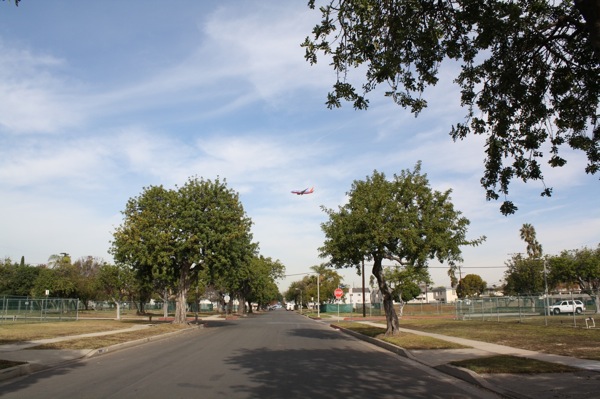United by common complaints against a particularly loud, disruptive neighbor, the residents who live under the flight path of Los Angeles International Airport are a relatively cohesive bunch. The Second District Court of Appeals has ruled, however, that neighborhood cohesion goes only so far.
According to the court's decision in City of Los Angeles v. Superior Court (2011), the city's voluntary program by which certain residents who live near the airport can sell their property to the city does not amount to a taking of adjacent properties.
In this case, plaintiffs argued that the city's program to purchase properties in areas near LAX and demolish the buildings constituted inverse condemnation of adjacent properties owned by plaintiffs. The decision illustrates the difficulty of establishing such a claim when a public entity does not directly invade a claimant's property. The court was not persuaded, and plaintiffs' suit was dismissed.
In 2000, the city established the "Voluntary Residential Acquisition and Relocation Program" for the neighborhoods of Manchester Square and Belford. According to the city, this program was created in response to residents who expressed a desire to relocate rather than to submit their homes to city-funded soundproofing as mitigation for the noise associated with the airport. As the name of the program implies, the city purchased properties from only those who chose to sell to the city—without ever invoking taking a property against an owner's wishes. By 2009, the city had spent several hundred million dollars to purchase and demolish 72 percent of the multi-family dwellings and 94 percent of the single-family dwellings in the area.
Unlike the majority of the property owners in Manchester Square and Belford, plaintiffs in the suit—including owners of rental properties within the neighborhoods—chose not to sell. Yet, as more and more buildings were demolished by the city, the number of renters in plaintiffs' properties continued to decrease as the neighborhood presumably became less appealing socially and aesthetically. Instead of selling their properties, plaintiffs brought suit against the city claiming inverse condemnation: the city's program, they claimed, devalued their property but offered no compensation.
The trial court agreed with plaintiffs. The city appealed, and the appellate court reversed.
In the appellate court's words, the central question in the case was "whether the City's creation of ‘condemnation blight' resulted in a duty to pay just compensation." In answering "no," the court discussed prior case law holding that "there is no property right appurtenant to plaintiff's property … which entitled him to the maintenance of his residences…" (Bacich v. Board of Control (1943) 23 Cal.2d 343; see also Hecton v. People ex rel. Dept. of Transportation (1976) 58 Cal.App.3d 653; Oliver v. AT&T Wireless Services (1999) 76 Cal.App.4th 521 [See CP&DR Legal Digest Vol. 15, No. 1, Jan 2000].)
The court also discussed another Supreme Court case, Klopping v. City of Whittier (1972) 8 Cal.3d 39, in which the City of Whittier had initiated and then withdrew condemnation proceedings while continuing to declare that it would one day condemn the property. The California Supreme Court found that this amounted to a compensable taking because the city's promised actions had lowered property values.
In this case, plaintiffs asserted that the principles in Klopping applied to the city's actions, and therefore, a taking had occurred. In comparing the facts in this case to those in Klopping, the court found that plaintiffs had failed to show any facts that would support a Klopping-style taking. Specifically, plaintiffs presented no evidence "that the City had condemned their properties, had intent to eventually acquire their properties through condemnation, or had a plan for future use of their property that would someday require condemnation of their properties – or any property in Manchester Square or Belford."
Contrary to plaintiffs' implications, the city's program was voluntary, and plaintiffs presented no evidence that any former owner felt coerced to sell their property to the city. The "blight" that emerged was therefore the result of voluntary actions which, though possibly detrimental to the remaining owners, were not directly influenced by the city. Under these facts, the court held that the city acted properly in acquiring and demolishing the properties, and plaintiffs were not entitled to compensation.
The Case:
City of Los Angeles v. Superior Court (2011) 194 Cal.App.4th 210

Photo Credit: Hillel Aron
